With half of my Summer Road Trip behind me, I finally left the friendly confines of a GT cockpit for a collection of open-wheeled and prototype cars in which I have much less experience.
The first car on my list — the Skip Barber Formula 2000 — is one that I should theoretically be familiar with. After all, it’s the closest car on iRacing to the Formula 2000 that I drove in the Bertil Roos Racing School at VIR ten years ago.
However, I’ve largely avoided that car and series on iRacing. I drove a few races in it when I first earned my D-class road license, but since then, I have mostly stuck to the GT cars at higher license levels.
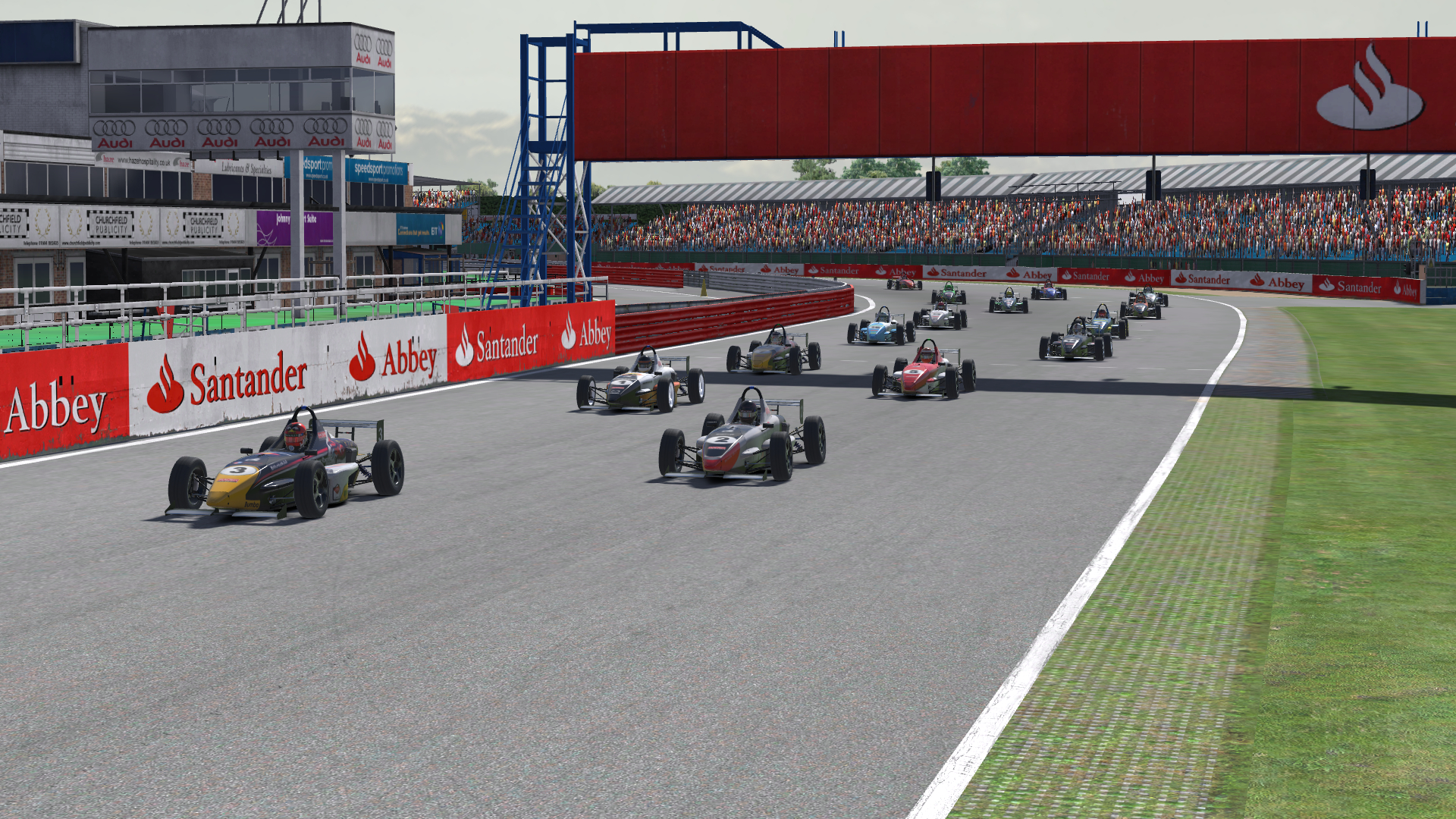
A field of Skippies slowly rolls off the starting grid.
My only foray into the Skip Barber series since then was a one-off race at Summit Point five years ago, which was a frustrating mid-pack run in which I was utterly uncompetitive.
Even though I haven’t been racing this car, plenty of other iRacers have been. In fact, it’s the most popular non-rookie road series on iRacing, even besting the GT3 in participation numbers. And with races going off every hour, it’s easy to find official race after official race in this series.
Despite being one of the oldest cars in iRacing, this car doesn’t seem to be getting old. So as I stepped foot onto the open-wheeled ladder last week, I set out to discover the draw of the Skippies.
The Shakedown
One thing’s for sure: Compared to the GT cars I raced in recent weeks, the Skip Barber is a bare-bones racecar. It has no anti-lock brakes or traction control, no fancy in-car dashboard displays showing lap times and fuel usage, and the front and rear wings are largely for show, as it has little to no downforce.
That makes it a great car for learning basic driving techniques and understanding how the car reacts. If you brake too late or don’t turn in soon enough, you’ll miss the apex. If you get back on the power too soon, you’ll push wide on exit.
With just 132 horsepower, this car also demands maximizing momentum and corner exit speeds. That was especially important at last week’s venue, the Silverstone Grand Prix course, which has several long straightaways connected by a combination of low-speed chicanes and high-speed sweeping corners.
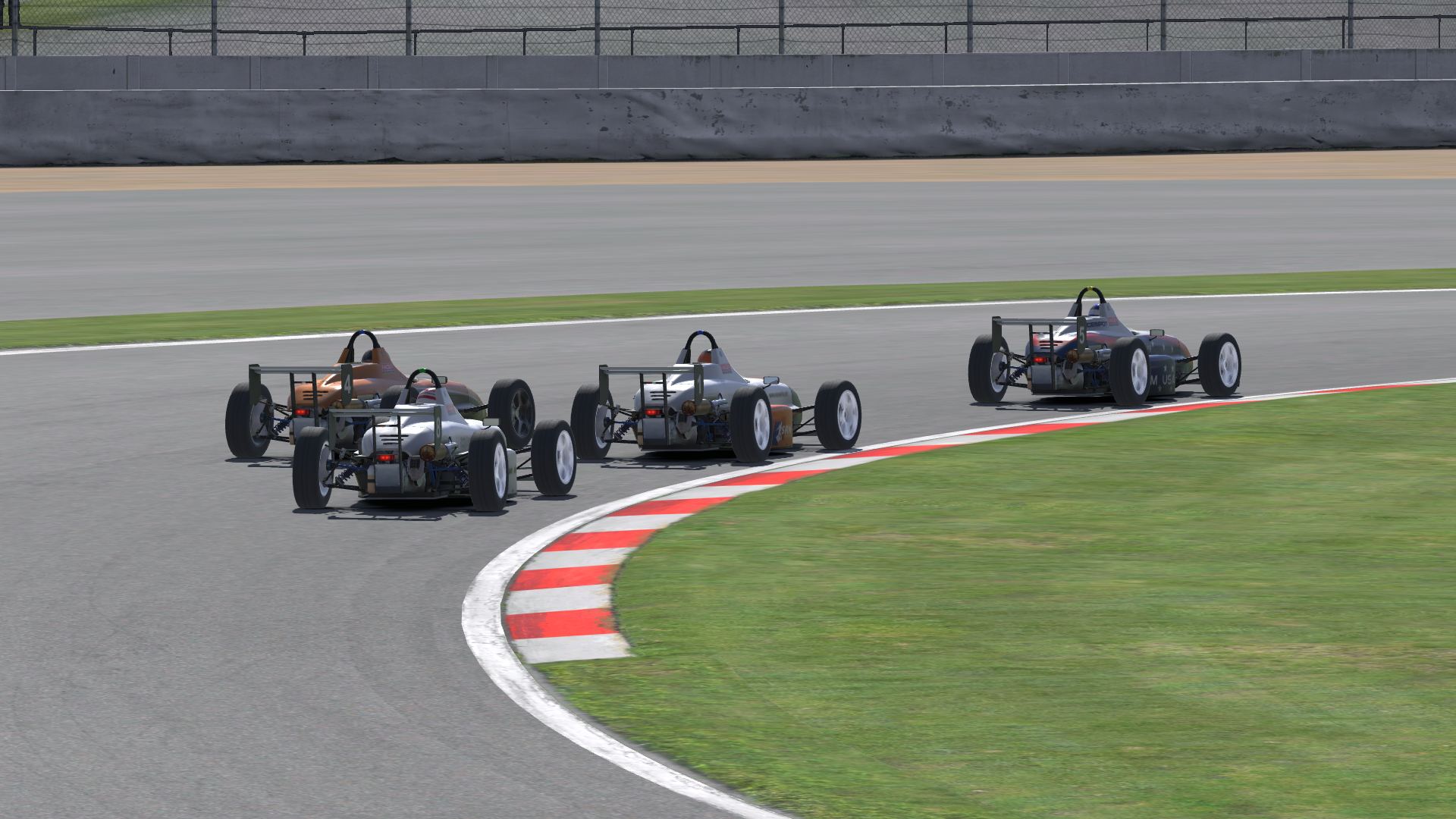
Close racing in a four-car pack.
The circuit is also very wide — enough to easily go three wide with several feet between cars — but as I found throughout the week, it’s not always a good thing to use the full width of the track in this car. In some places, like exiting the Chapel corner or entering Priory, it’s better to keep the car toward the inside or middle of the road. Anything wider is literally a waste of time.
Consistent with its bare-bones amenities, the available setup adjustments on the Skip Barber car are also limited. Other than changing the fuel level for qualifying, the only adjustment I made all week was lowering the tire pressures for a particularly warm race.
As I stepped into a completely different car from anything I’ve raced recently, it was time for a refresher on some fundamentals of racing.
Fundamental 1: Learn the Limits
For my return to the Skip Barber series, I wanted to dip my toes into the water rather than jump straight into the deep end. So for my first event, I chose the timeslot just after a broadcasted race.
With most of the heavy-hitters choosing to run that earlier event, the competition in my race wasn’t as strong. In fact, as the top driver by iRating in the field, I wasn’t just hoping to keep up; I felt the pressure to come away with a high finishing position.
I qualified in third but lost two positions entering the esses. I re-passed one of those cars down the Hangar Straight, and it’s a good thing that I did, because the two cars behind me crashed entering the tight Club corner, narrowly missing the back of my car.
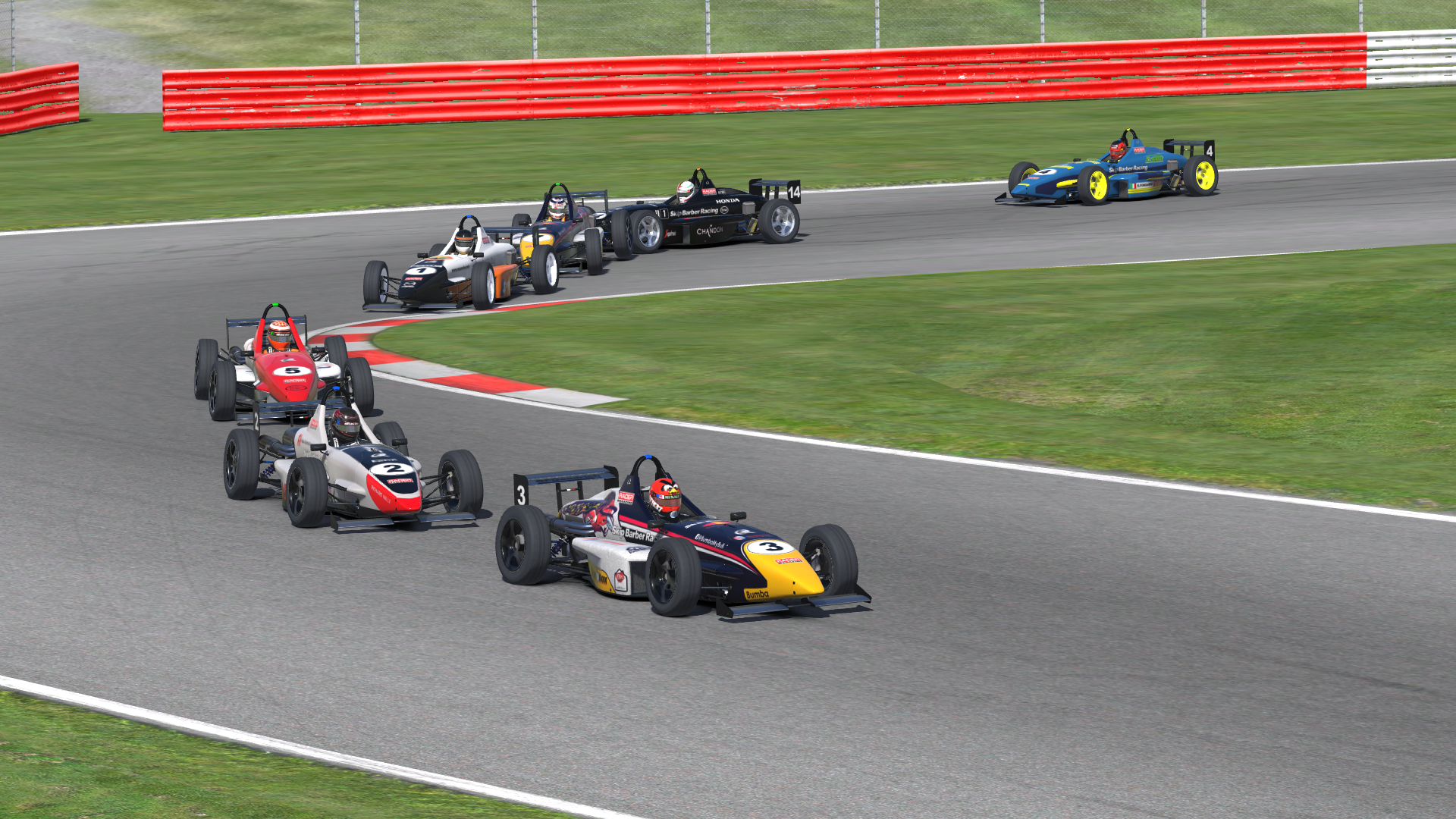
The cars behind me make contact entering Club corner.
Their crash took away any close competition behind me, so I could simply focus forward and run my own race. I found myself on the edge of drafting range of the three leaders, but in the early laps, they were all cooperating instead of battling, which made my job tougher.
As I pushed harder to try to keep up, I started making mistakes as I overdrove the car’s limits. Whether it was braking a bit too late or getting back on the throttle a bit too early, those mistakes added up and the lead trio was soon several seconds ahead and seemingly out of reach.
On the final lap, though, they started racing, and two of them spun out as they exceeded the cars’ limits themselves. Just staying on the circuit gained me two positions, elevating me to a second-place finish. However, in a flashback to my mid-pack mediocrity five years ago, I couldn’t shake the feeling that my performance didn’t merit such a good result.
Skip Barber Race Series - Race 1
Wednesday, July 26 at 9:15 pm EDT • Strength of Field: 2001| Finish | Start | Interval | Laps Led | Fastest Lap | Incidents | Points | iRating | Safety Rating |
|---|---|---|---|---|---|---|---|---|
| 2 | 3 | -2.806 sec. | 0 | 2:08.569 | 1 | 112 | 4568 (+22) | A 3.20 (+0.14) |
Fundamental 2: Don’t Wreck Your Teammate
For my second race, I was excited to get back on track with my teammate Karl Modig. We had already raced together this season in the Porsche and Mercedes, and as in those races, we qualified within one position of each other on the grid — seventh for him and eighth for me.
The race started calmly enough, running single-file through the esses. But as we rolled onto the Hangar Straight, the trouble began.
I was just behind Karl but didn’t want to pass him for fear of losing touch with the cars ahead. So instead, I wanted to be a helpful teammate and give him a push down the straightaway — a move most commonly associated with NASCAR but not unheard of in open-wheelers, either.
Unfortunately, my attempt was less-than-proper bump drafting. After an initial tap, his car lurched slightly to the left, and my second tap was nearly on his right-rear tire. That sent us both spinning and crashing into the wall.
He laughed it off and said he expected no less from a veteran stock car sim racer.
“I can see why the Australians didn’t care for your driving,” he joked, referring to my tumultuous week in the V8 Supercar Series.
Alas, I broke the first rule of motorsports, and all we had to show for it was two wrecked cars and big iRating and safety rating losses.
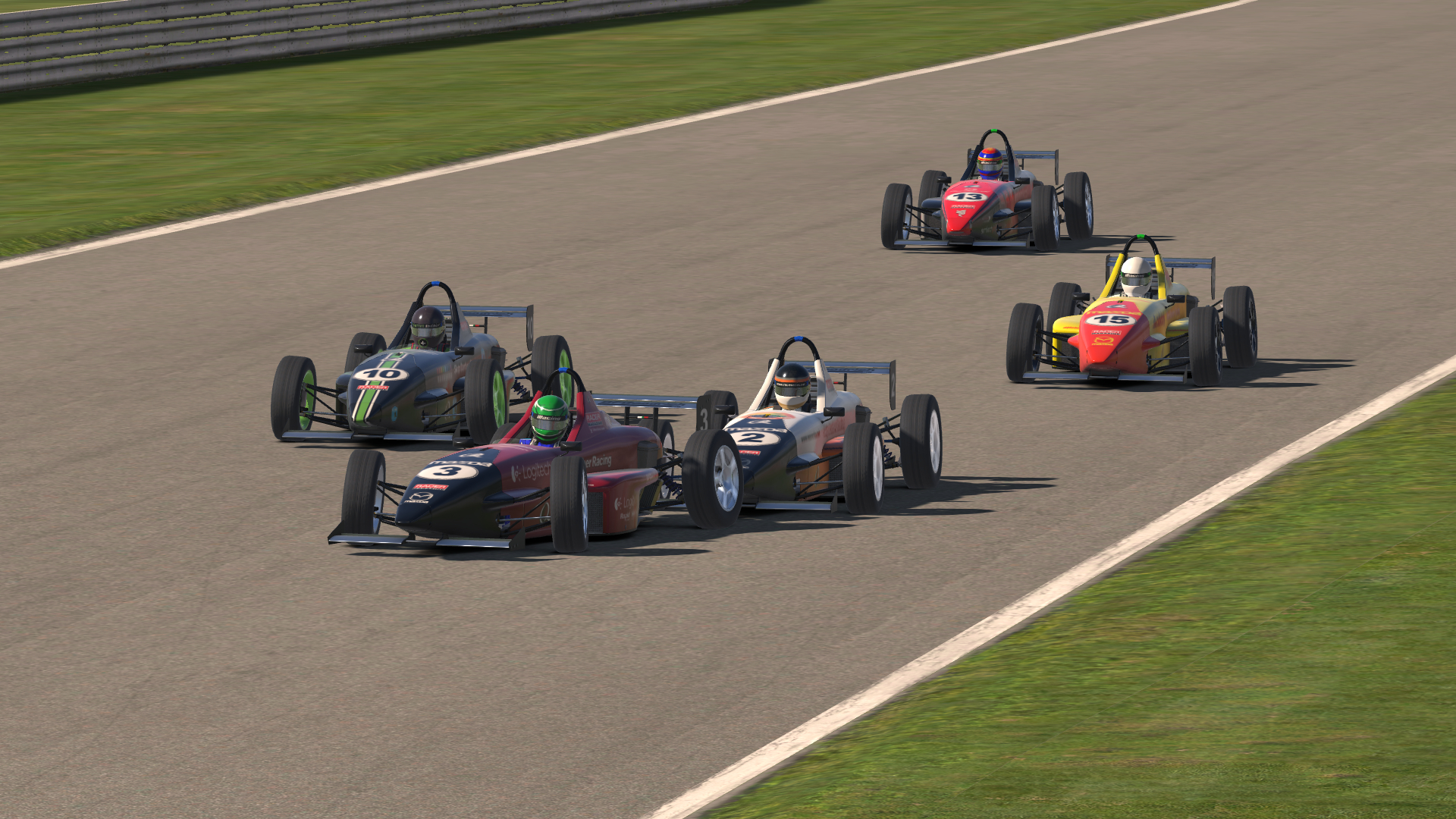
Oops.
Skip Barber Race Series - Race 2
Thursday, July 27 at 6:15 pm EDT • Strength of Field: 2866| Finish | Start | Interval | Laps Led | Fastest Lap | Incidents | Points | iRating | Safety Rating |
|---|---|---|---|---|---|---|---|---|
| 14 | 8 | -11 laps | 0 | -- | 5 | 12 | 4452 (-116) | A 3.03 (-0.17) |
Fundamental 3: Patience is a Virtue
I ran another race that night, and probably wisely, Karl decided not to join me. That meant I couldn’t fall afoul of the second fundamental again, but I knew I still had a lot to learn about actually racing in the Skippies.
A close, race-long battle with other cars was just what the doctor ordered, and that’s exactly what I got. While a pack of four speedy leaders pulled away from the start, I found myself in my own four-car pack for much of the race.
Early on, I dropped to the back of that group, and it wasn’t because of mistakes or a lack of pace. I mainly wanted to be patient and see how the car felt in the draft.
It didn’t take long before that patience paid off. On lap 4, contact between two of the drivers at the front of the group sent one of them spinning in Stowe corner. Our pack of four was down to three, and I was right in the middle of it.
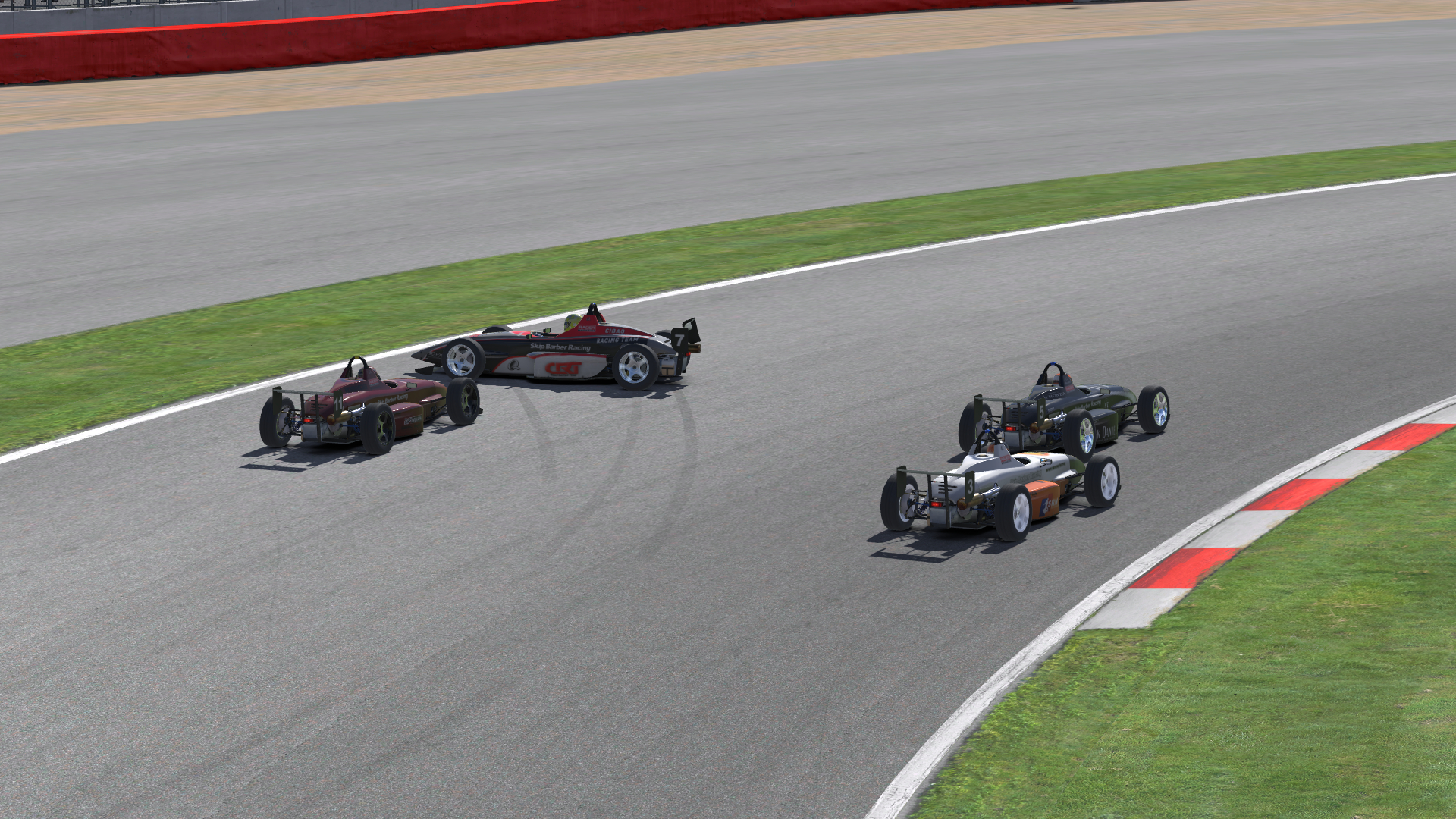
Getting past a lap-4 crash at Stowe corner.
I was very much learning on the fly, so I still made a few mistakes as I got used to racing so closely with other cars. Several times, I panicked in braking zones and locked up, but unlike in my first race, those mistakes didn’t keep me out of the battle.
Throughout the race, I wasn’t sure how aggressive I should be, and with my dumb mistake from the previous race still fresh on my mind, I played it conservatively. Instead of making risky attacks, I worked together with the cars around me to keep our pack in tact and keep myself in contention until the end.
With two laps to go, I found myself in fifth place leading our pack, so I began to defend the position down the Hangar Straight. On the last lap, the car behind me made an outside pass there, which dropped me back to sixth.
On paper, it wasn’t a spectacular finishing position, especially considering that I was more than 14 seconds adrift of the winner. But I did learn a lot about how these cars race, which gave me confidence entering my final start of the week.
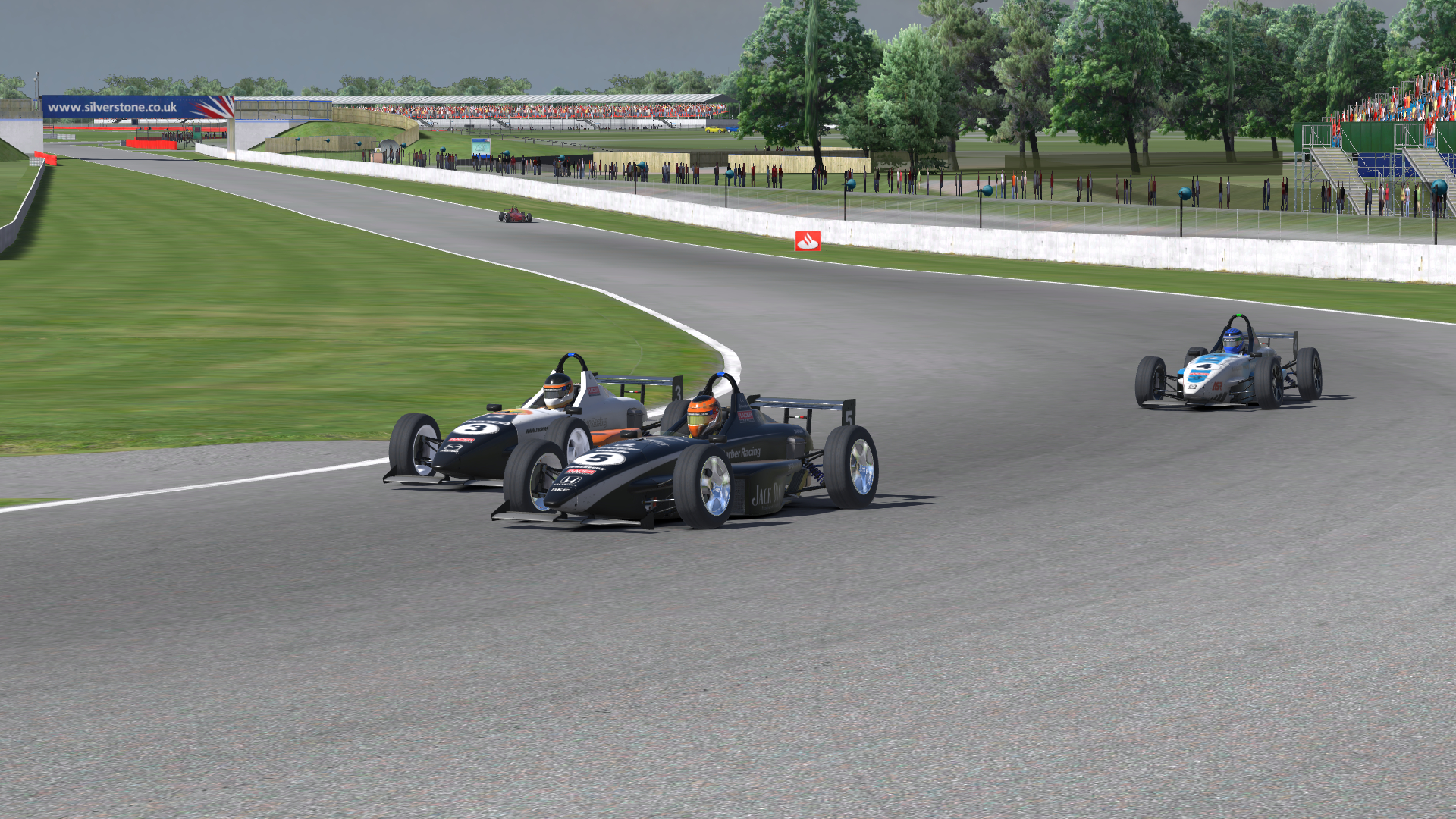
Racing hard for fifth place on the final lap.
Skip Barber Race Series - Race 3
Thursday, July 27 at 8:15 pm EDT • Strength of Field: 2461| Finish | Start | Interval | Laps Led | Fastest Lap | Incidents | Points | iRating | Safety Rating |
|---|---|---|---|---|---|---|---|---|
| 6 | 7 | -14.373 sec. | 0 | 2:08.306 | 1 | 98 | 4443 (-9) | A 3.17 (+0.14) |
Fundamental 4: Never Stop Improving
For that race, I again found myself as the #1 car, which brought back the pressure to finish among the leaders. But after qualifying in fifth, more than half a second off the polesitter, I knew that task might be tough, especially if I lost ground on the first lap.
With that in mind, having the cars ahead of me go three-wide into the esses was exactly what I didn’t want to see. One of them ran through the grass, which forced me to take a wide line to avoid him and nearly put me out of touch with the three surviving leaders ahead.
But between my own clean driving and their early raciness, I caught back up and found myself safely in the lead pack.
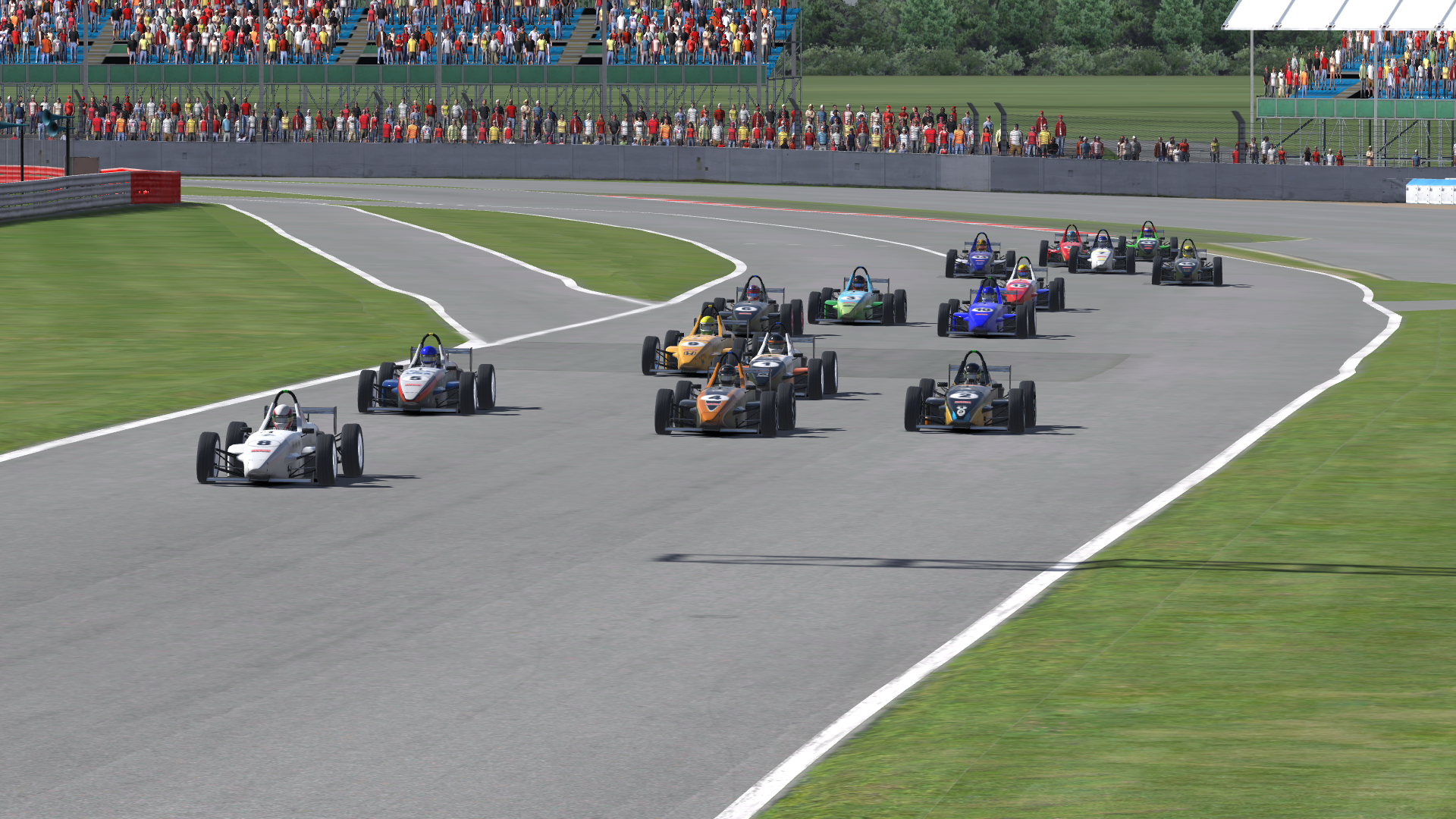
The cars ahead of me race three-wide into the esses.
As in my previous race, I mostly stayed toward the back, again practicing patience early on and working together with the cars ahead of me instead of battling them and splintering our lead foursome.
With four laps to go, my patience was again rewarded. Contact between the top two cars in the Abbey chicane sent them both spinning while the third-place driver and I squeezed through to become a lead pack of two.
We weren’t in the clear, though, as a car further back caught up while we slowed to avoid the spins. If I started racing the leader, that other car would’ve surely caught us.
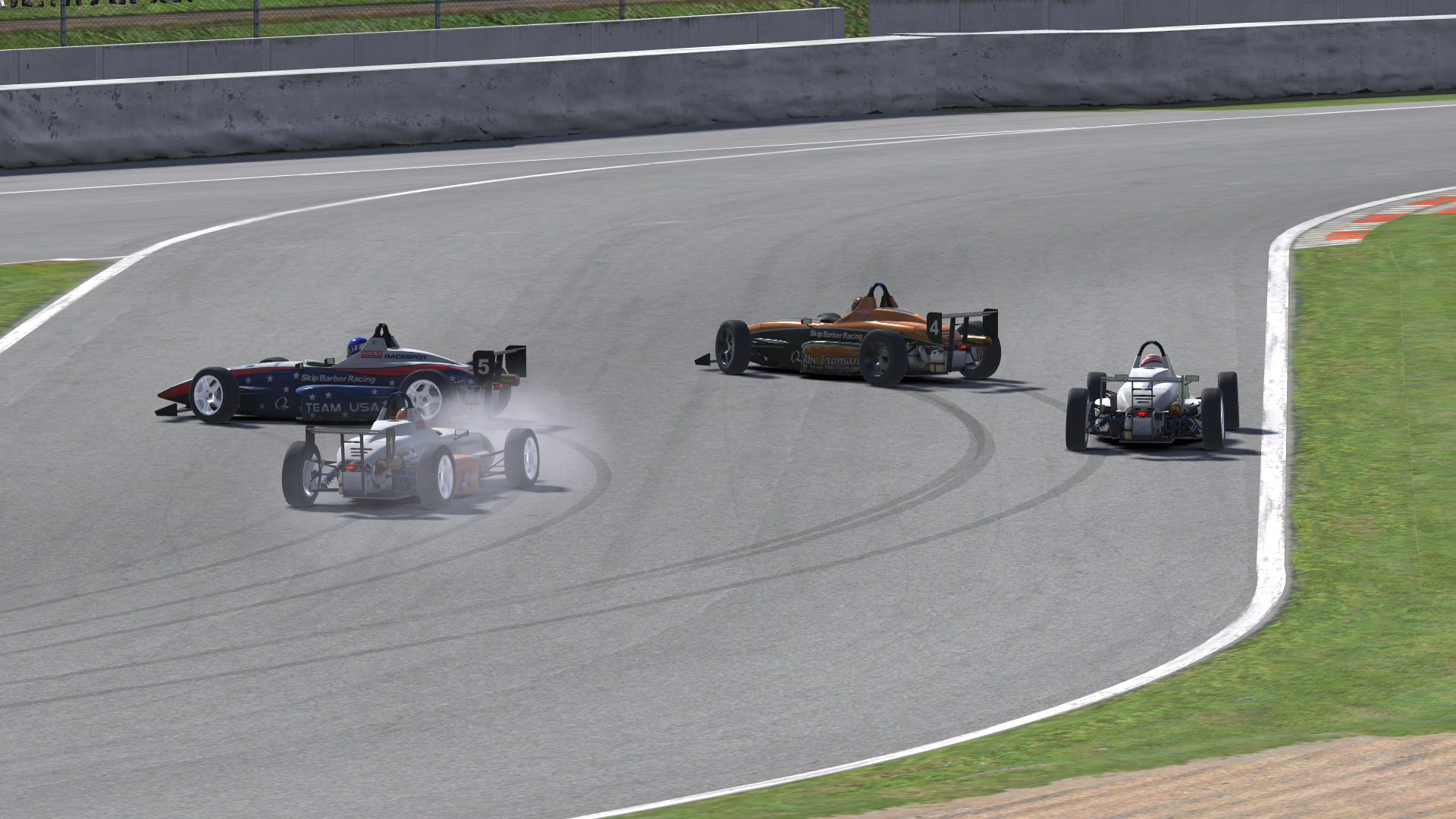
Driving through the smoke of the spinning leaders ahead of me.
Instead, I stayed in his draft, and this time, I knew better than to bump him. I also avoided losing time as I had in previous races by locking up in braking zones or running wide after carrying extra speed into corners. That kept us clear of the car behind entering the final lap.
While I was firmly in the draft, I wasn’t close enough to make a move, which kept me in second place until the finish. For the second time in the week, I finished second as the #1 car, but this time, based on my pace, patience, and performance, I thought I deserved it.
Skip Barber Race Series - Race 4
Friday, July 28 at 7:15 pm EDT • Strength of Field: 2470| Finish | Start | Interval | Laps Led | Fastest Lap | Incidents | Points | iRating | Safety Rating |
|---|---|---|---|---|---|---|---|---|
| 2 | 5 | -0.848 sec. | 0 | 2:07.941 | 3 | 135 | 4476 (+33) | A 3.23 (+0.06) |
Newfound Knowledge
In a car ideal for learning, I certainly learned a lot in just four races.
In some cases, like with drafting and side-by-side racing, that knowledge came in the classroom environment that only a race can truly provide; practice just doesn’t quite have the same intensity or consequences.
I also learned from watching others. By studying the laps of faster drivers, I discovered better lines to take, shifting points to use, and approaches to some of the trickier corners.
And, of course, I learned from my own mistakes by seeing how hard I could push and when to bump draft (hint: never).
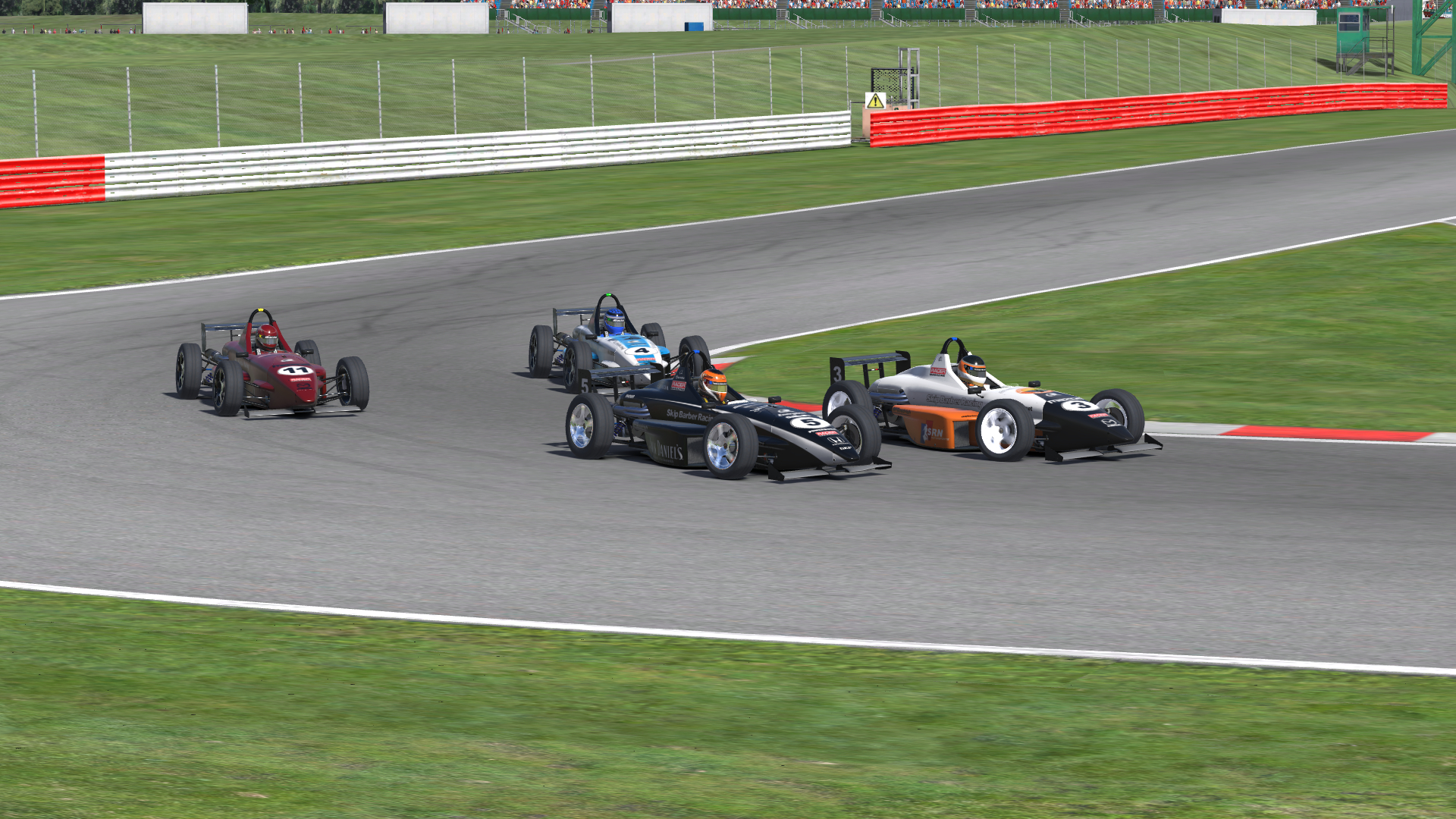
A fun four-car, two-wide battle through Club corner.
But did I learn what makes this series so popular? After all, that was my goal entering the week.
Although the car itself is uninspiring at best, I think its simplicity is a big reason why it’s such a draw. Pro drivers always want skill rather than setups to shine so they can prove they’re the best, and the Skip Barber Race Series provides that opportunity.
Sure, the draft can be a great equalizer, sometimes keeping slower drivers in touch with the cars ahead, but it still requires speed and discipline to stay in the slipstream, at least to a greater extent than a NASCAR race at Daytona or Talladega.
Of course, that’s easy for me to say now. If only I knew at the start of the week that I shouldn’t drive the Skippy like a stock car.